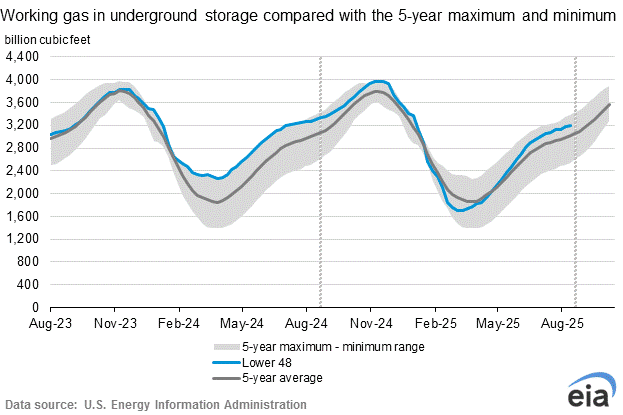Energy Markets Update
Weekly natural gas inventories
The U.S. Energy Information Administration reported last week that natural gas in storage increased by 115 Bcf. There was an injection for the same week last year of 105 Bcf while the five-year average injection is 91 Bcf. Total U.S. natural gas in storage stood at 2,215 Bcf last week, 14.7% less than last year and 2.8% lower than the five-year average for this time of year.
Renewable natural gas in Midwest
California’s Low Carbon Fuel Standard (LCFS) is driving development of the renewable natural gas in the Midwest. The state’s LCFS is a market-based incentive program is designed to reduce the carbon footprint of transportation fuels in California through the use of a range of alternative low-carbon renewable fuels, which are compensated proportionately with the inverse of their carbon intensity. Under the program, Renewable Natural Gas (RNG) has the lowest carbon intensity since it is produced by capturing and processing the methane emitted from organic sources including dairy waste, wastewater treatment plants, food waste, landfills, and forest management.
According to the California Air Resources Board, RNG made up nearly 90% of all natural gas vehicle fuel consumed in the state last year– a significant milestone that pushed the weighted carbon intensity value of natural gas vehicles below zero for the first time. RNG plants generate revenue from the production of credits or Renewable Identification Numbers (RIN) attributed to every gallon of RNG used. The purchase of RINS is required by larger refiners pursuant to the federal Renewable Fuels Standard (RFS), but they are also monetized in California and Oregon’s state mandates.
However, some obstacles faced by RNG expansion is the millions it costs to process the methane and the requirement of a custom design for each project, making it difficult to replicate nationwide. California expects 160 RNG production facilities will be supplying more than 15.8 million MMBTU to transportation clients by 2024, placing the industry on a prospering path in future markets.
Although RNG prices remain volatile in the market and does not always have abundant liquidity and hedging products, spot prices have recently settled between $15-25/MMBtu. Prices for the LCFS vary considerably, but certain applications on dairy farms can fetch upwards of $75/MMBtu and higher. The market has declined modestly in response to the federal RFS program and the 40+ bills that have been introduced across the US in support of RNG programs, but the premiums are a potential boon to those in a position to clean and transport the gas. This has caused explosive growth across the West and Midwest, particularly in the dairy industry where RNG prices are highest and farm operators are eager to seek out opportunities in a business otherwise known for having razor thin margins.
Please contact your SourceOne representative with questions about how to monetize RINS through your waste-to-energy process or your consumption of natural gas as a transportation fuel
D3 RIN Price, $ gal. (Conversion = 11.727 MMBtu per RIN)
Source: https://www.epa.gov/fuels-registration-reporting-and-compliance-help/rin-trades-and-price-information
AZ regulators lax 100% clean energy target
On May 26th the Arizona Corporation Commission voted to require electric companies to source 100% of their electricity from carbon-free sources by 2070. Arizona regulators extended this energy rules package 20 years later than the previously proposed 2050 deadline the commission rejected earlier this month. Under the proposed rules the state will still be required to meet short-term targets, including a 50% reduction in carbon emissions by 2032 and an 80% reduction by 2050, as well as other interim obligations. While the bipartisan rule is not final, the approval pushes the rules into the “supplemental rulemaking” phase, a process that requires the updated package to undergo public comment and another vote by the commission in the fall before being sent to the attorney general for review.
Natural Gas Storage Data


Market Data
Use the filters to sort by region
Market data disclaimer: Data provided in the "Market Data" section is for the newsletter recipient only, and should not be shared with outside parties.




